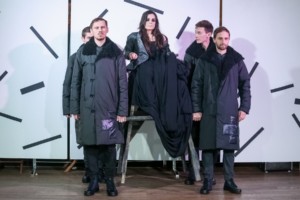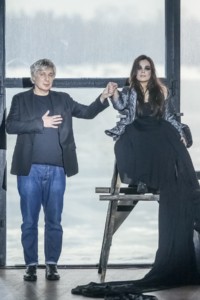Alexandra Kutas, Ukraine’s “wheelchair model” talked to the Kyiv Post right after the presentation of her fashion video and show on Feb. 3.
“What do you do when you don’t know what to do? Add confidence. You can do anything – just do it confidently,” Kutas said.
Dnipro-born Kutas was born paralyzed from the waist down, but decided at age 16 to go into the hyper-competitive industry of modeling.
She achieved her goal and then some: At Kyiv’s ArtPrichal art space she and Ukrainian designer Fedir Vozianov premiered the first fashion video with a wheelchair model and the first fashion show in Ukraine dedicated to a model with disabilities.
Far from being disabled, “these women most often have unlimited abilities,” Vozianov told the Kyiv Post.
The fashion video, directed by Denis Vorobyov, was shot in a day at the end of January. Both Vozianov and Kutas played a big role in its production, with Kutas saying she provided input at every stage, “from script-writing to deciding which frame goes where.”
Kutas stars in a powerful video which shows her trying to release herself from a pair of female hands. She described it as a “fight with your own self.”
Just like Vozianov’s fall-winter 17-18 collection, the video goes by the title Viy (a figure in Ukrainian demonology and the title of a horror novella by Ukrainian writer Mykola Gogol).
As Kutas explained, the story depicted by the video starts calmly, and then develops into a fight – “a fight with your own self.” A pair of female hands grabs Kutas’s face and shoulders – they represent her inner negative feelings and insecurities. Kutas then struggles to release herself, and succeeds.
Following the premiere of the video, Vozianov’s fall and winter 17-18 fashion was held, in which Kutas also played a starring role, being carried out in a tall chair designed specifically for the event.

Male models carry Kutas on a chair that was specifically designed for this event. (Mercedes-Benz Kiev Fashion Days)
“We spent long time thinking about how exactly I should appear on the runway, and how it should look,” Kutas explained, adding she had been very pleased with the effect.
“There wasn’t a chair in existence in the world that we thought would fit this concept and idea. So we created our own,” she said.
Vozianov adds: “The chair was made in just a day. We sketched the idea, and our partner Oleksiy made it come to life. It was almost a spontaneous act.”

Following the premiere of the video, Vozianov’s fall and winter 17-18 fashion was held. (Kostyantyn Chernichkin)
Kutas remained sitting on the chair, with a large panoramic window behind her displaying a stunning view of the ice-covered Dnipro River– creating a powerful image.
The models walked the runway while Kutas gradually dragged a long piece of fabric towards herself.
“It was harder than I imagined it to be. The fabric was heavy and I had so many things to think about at once.”
“But I hope it looked as powerful as it felt.”

Kutas met Vozianov in November and they “connected straight away.” (Mercedes-Benz Kiev Fashion Days)
Kutas has had some modeling success in Ukraine, serving as the emcee of Ukrainian Fashion Week in 2014 and having a photographic exhibition dedicated to her. But most of her work is still done abroad, including photo shoots for U.S. magazines.
“Working in this direction in Ukraine is more difficult. Not all brands are ready for this. But I’m sure it’s just a matter of time.”
Things are changing, Kutas says, adding that making this video and fashion show was already “the biggest breakthrough that you can think of.”
She met Vozianov in November and they “connected straight away.”
“It wasn’t a question of whether we will work together, it was more of how we should do it,” Kutas said.
The social message behind this work is that a human being needs to be a professional first. Kutas hopes that people with disabilities will be considered professionals one day.
“It’s all just a matter of how much time it takes society to do it,” she says.
